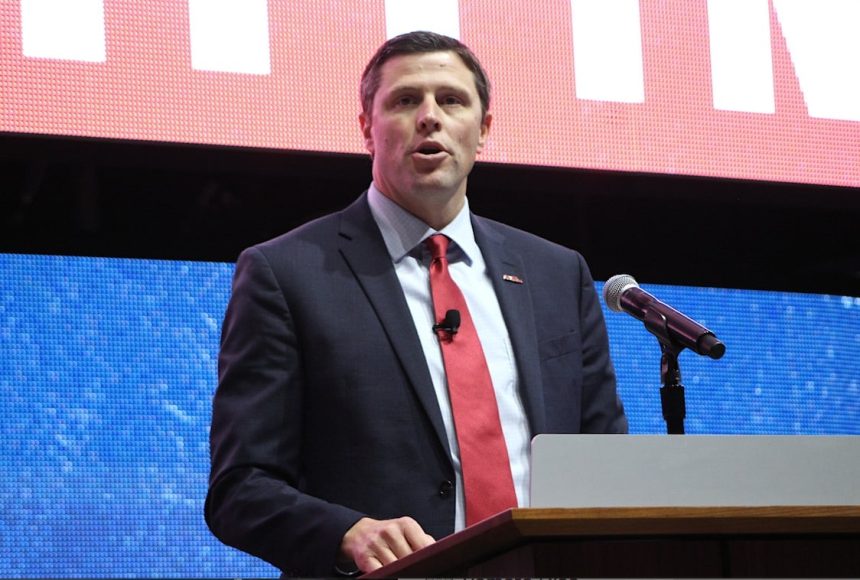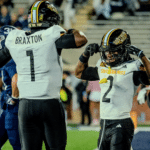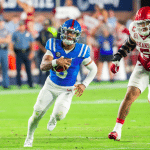A landmark decision by a federal judge has shaken the landscape of college athletics at its core, and leaders are now having to quickly prepare for impending changes.
Last week, U.S. Senior District Judge Claudia Wilken finally resolved three antitrust settlements, opening the door for universities’ athletics departments to share up to $20.5 million of their annual revenue with student-athletes. Additionally, the NCAA is set to distribute roughly $2.8 billion in back pay over the next 10 years to current and former Division I athletes who competed since 2016.
The decision by the judicial leader was all but inevitable. However, the final decision had been delayed due to setbacks over roster limits, possibly putting walk-on athletes’ positions on a team in peril.
Now, athletics directors across the NCAA’s 1100+ member institutions are looking to navigate the waters of the ever-changing makeup of college athletics as the former model of amateurism has essentially been ditched, though players are currently not being considered university employees despite being in line to be paid directly by their respective schools.
The decision also changes the structure of name, image, and likeness (NIL) compensation for student-athletes. Now, collectives and other NIL liaisons will be required to have any compensation deals over $600 approved by a clearinghouse administered by professional accounting firm, Deloitte. This move was set in motion to ensure players receive “fair-market” valuations in future NIL deals.
Currently, back payments to former athletes have been put on hold as a group of female athletes has challenged the settlement over Title IX concerns. The challengers claim the House vs. NCAA settlement violates gender equity statutes. Specifically, the group is contending that the settlement’s allocation of $2.4 billion to former male student-athletes and only $102 million to their female counterparts is not legal.
Nonetheless, despite the first of many expected challenges to the settlement heading to the courts, revenue sharing is still expected to launch on July 1, though there is an anticipation that athletes participating in sports that don’t generate revenue will pursue litigation after not receiving a piece of the pie.
Here’s how prominent officials in Mississippi are reacting to arguably the biggest change to college sports ever:
Ole Miss Athletics Director Keith Carter
Carter has pledged to allocate the full $20.5 million allowed to student-athletes through new scholarships and cash distributions, while student-athletes continue to receive NIL funds to make up for any figure they may desire while at Ole Miss. The Rebel athletics director, through a written statement, maintained a sense of confidence that the new revenue sharing model will benefit the players in the long run.
“This settlement not only provides unprecedented financial opportunities but also enhances support services, including mental health resources, nutrition programs, and extended medical coverage, ensuring our athletes thrive both on and off the field,” Carter stated in a press release. “While the past few years have seen Ole Miss reach historic heights, we look forward to embracing a new model in college athletics and finding some much-needed stability.”
A new era of college athletics is upon us. We look forward to continued success as we embrace this change. Let’s keep going! 🔴🔵 https://t.co/NcV5KxLQt0
— Keith Carter (@KeithCarterOM) June 12, 2025
Ole Miss, after restructuring tailgating at the Grove and parking prices for athletic events to accrue extra revenue, is building upon its relationship with private partners to better market student-athletes, allowing the players to earn financial benefits through NIL deals.
“While it may look different moving forward, we are excited to expand our relationship with The Grove Collective and Magnolia Sports Group. Their partnership, coupled with the extensive reach of Ole Miss Sports Properties and Learfield Impact NIL service, should lead to countless marketing opportunities for our department and our student-athletes,” Carter continued
“The revenue generated by these groups comes in addition to the vitally important capital support of the Ole Miss Athletics Foundation, which continues to drive major gifts fundraising as well as tickets, parking, and other gameday services. It’s only through these partners that we can provide the preeminent student-athlete experience that is a staple of our athletics culture.”
Carter has also committed to working with the College Sports Commission, a newly established regulatory entity tasked with enforcing NIL deals and revenue sharing, to ensure Ole Miss is complying with current rules.
“We are committed to the new model and working with the new College Sports Commission. While change can be challenging, we are prepared for the new era of intercollegiate athletics,” Carter said. “Ole Miss has never had a brighter future, due in large part to the unwavering support of our fans and donors. We couldn’t have reached this point without their passion, and we look forward to embarking on this journey together.”
Mississippi State Athletics Director Zac Selmon
Selmon, noting that there is still much yet to be revealed about how the new settlement will shape college sports, has expressed relief that there is more clarity now than there had been in prior months.
“Friday’s settlement in the House vs. NCAA case marks a pivotal moment for college athletics,” Selmon stated on social media. “While there are still questions to answer and new territory ahead, this decision allows us to officially move forward with plans to share revenue with our student-athletes.”
— Zac Selmon (@zacselmon) June 7, 2025
Selmon is adamant that the revenue sharing model can help Mississippi State capitalize on its existing athletic infrastructure and bolster its various teams through a commitment to compensating student-athletes.
“We are entering a new era. That brings uncertainty, but also opportunity to grow, to lead, and to strengthen the foundation already in place,” Selmon said. “With this clarity, we can continue building strong, competitive programs for the future.”
Selmon, who has witnessed Mississippi State Athletics secure millions in donations and pledges, along with an incoming $60 million indoor football practice facility, is asking Bulldog faithful to continue supporting the program. He contended that fan and donor support is vital for Mississippi State to compete in college sports’ toughest conference.
“Our coaches and staff are energized by what lies ahead. They are committed to guiding our programs through this next chapter. We’re grateful to every member of the Bulldog Family who continues to support our mission. Your passion is unmatched, and your belief in our direction will be key as we shape the road ahead.”
The athletics director promised to provide more information about Mississippi State’s upcoming revenue sharing plans “in the coming weeks.”
Southern Miss Athletics Director Jeremy McClain
McClain, who oversees a $30 million athletic budget, made it clear that Southern Miss will not allocate the full $20.5 million to its student-athletes, but Golden Eagle players can expect a seven-figure allotment distributed at the discretion of department heads.
In order to bridge the gap, McClain has committed to helping athletes accrue revenue through all legal NIL channels that they may not be able to acquire through revenue sharing.
“For us, out of the gate, it’s going to be about continuing to help our student-athletes brand themselves. The [To The Top] collective is going to create some opportunities, whether it be through interviews, whether it be through opportunities that might fit within the regulations,” McClain said on SportsTalk Mississippi. “I think there’s an opportunity for that to be an arm for us and help our student-athletes create and grow their brands.”
For the betterment of the future of college athletics, McClain says he agrees with the “unpopular” idea that permanent regulation from the federal level is necessary. The primary characteristic of proposed federal guardrails floated by administrators would be the creation of a collective bargaining agreement that would prevent student-athletes from holding employment status while still allowing them to receive financial benefit from their schools.
“We really need some federal help to try to figure out how to get to a place where we can either put some parameters in place or get to collective bargaining without our student-athletes becoming employees,” McClain said. “Today, that’s probably not feasible, and that’s why we need assistance.”
Former SEC Executive Committee Secretary Ron Rychlack
Rychlack, also a law professor at Ole Miss, is hopeful that the settlement will remedy much of the “Wild West” nature of the current landscape of college sports. A defined compensation plan agreed to by multiple parties, including players and NCAA member institutions, gives the legal expert confidence that a step in the right direction was taken.
“Hopefully this will provide some stability, at least for a while, while trying to maintain competitive equity and fairness for the players and financial stability for the programs,” Rychlack said on MidDays with Gerard Gibert. “Hopefully, because of the agreement that was worked out between the NCAA, the conferences, and the plaintiffs, this will provide a moment of peace.”
However, new opportunities pose new challenges. For schools like Ole Miss and Mississippi State, a pursuit to keep up with the Joneses of the SEC will be a $20.5 million annual problem. For these institutions, and others in a similar position, to thrive, Rychlack maintains that they will need to be creative in budget cuts or finding new revenue streams.
“In the SEC — if they want to be competitive — certainly for [Mississippi] State and Ole Miss, they’re going to have to spend $20.5 million of revenue share with their athletes,” Rychlack remarked. “That means they have to find that money either with cuts or with additional revenue coming in just to maintain competitive balance across the conference.”
Mississippi Gov. Tate Reeves
Reeves, painting a bleak picture of the future of college athletics, said the quiet part out loud. The roster spots for athletes participating in non-revenue-generating sports could very well be in limbo as programs are slated to look to scale back on monetary support for teams and clubs that do not turn a profit. To Reeves, a father of three daughters, this means women’s sports will likely be the first target of these budget cuts, limiting the amount of scholarships available to prospective athletes.
“It appears to me that the non-revenue sports are going to get squeezed,” Reeves told the press on Tuesday. “There are going to be fewer female collegiate athletes in the future because of this settlement, and I think that’s a crying shame.”
As for how well-equipped universities in Mississippi are to handle the task of doling out millions from their athletics budgets, Reeves has no doubt that the programs in the state participating in revenue sharing will be a shining star among their peers.
“The amount of money being involved [in college athletics] nowadays certainly creates challenges, and those are challenges that our universities are going to have to work through,” Reeves added. “At the end of the day, what has been proven over and over again is that we can compete with anyone anywhere in the world.”
Reeves, like Jeremy McClain, also offered his support for a federal solution to the future revenue sharing structure of intercollegiate sports in hopes that Congress could place a one-size-fits-all model with clearly defined regulations in place for the NCAA’s member institutions.
Mississippi Lt. Gov. Delbert Hosemann
Hosemann touted efforts to allow student-athletes to be compensated, especially in an era in which coaches, conferences, and television executives are reaping the benefits of the players’ work. However, the elected official believes a dangerous slippery slope was trekked, creating the modern state of college sports.
“Young people deserve to be paid. That’s one part of it,” Hosemann said on Mornings with Richard Cross. “The coaches got to be paid so much money, and the young people were getting nothing, and the pendulum swung too far.”
With revenue sharing becoming a new norm, Hosemann fears women’s sports and some men’s sports, like track and field, which produce Olympic athletes, will either be cut or met with a critical lack of financial support in order to prop up football, men’s basketball, and baseball in a state like Mississippi.
On the other hand, the lieutenant governor also fears that Mississippi’s major institutions could suffer the unintended consequences of certain conferences lacking one major sport taking a lion’s share of its $20.5 million with athletes of another major sport, handicapping a Magnolia State institution from being able to acquire high-skilled players.
“In the Big East, they don’t have football. So now they have $20 million for St. John’s basketball players. Their starting point guard will be making $2 million to $2.5 million or $3 million,” Hosemann said. “Our starting point guard at Mississippi State won’t be able to make that much.”
While officials have presented mixed reactions to the recent settlement, the consensus sentiment is that Mississippi schools participating in revenue sharing will distribute a bulk of the funds to football players, followed by men’s basketball players and baseball players.








